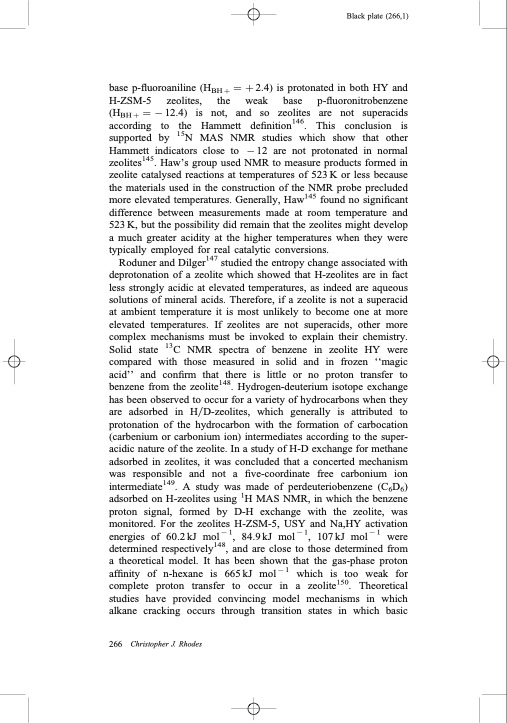
PDF Publication Title:
Text from PDF Page: 044
Black plate (266,1) base p-fluoroaniline (HBH þ 1⁄4 þ 2.4) is protonated in both HY and H-ZSM-5 zeolites, the weak base p-fluoronitrobenzene (HBH þ 1⁄4 12.4) is not, and so zeolites are not superacids according to the Hammett definition146. This conclusion is supported by 15N MAS NMR studies which show that other Hammett indicators close to 12 are not protonated in normal zeolites145. Haw’s group used NMR to measure products formed in zeolite catalysed reactions at temperatures of 523 K or less because the materials used in the construction of the NMR probe precluded more elevated temperatures. Generally, Haw145 found no significant difference between measurements made at room temperature and 523 K, but the possibility did remain that the zeolites might develop a much greater acidity at the higher temperatures when they were typically employed for real catalytic conversions. Roduner and Dilger147 studied the entropy change associated with deprotonation of a zeolite which showed that H-zeolites are in fact less strongly acidic at elevated temperatures, as indeed are aqueous solutions of mineral acids. Therefore, if a zeolite is not a superacid at ambient temperature it is most unlikely to become one at more elevated temperatures. If zeolites are not superacids, other more complex mechanisms must be invoked to explain their chemistry. Solid state 13C NMR spectra of benzene in zeolite HY were compared with those measured in solid and in frozen ‘‘magic acid’’ and confirm that there is little or no proton transfer to benzene from the zeolite148. Hydrogen-deuterium isotope exchange has been observed to occur for a variety of hydrocarbons when they are adsorbed in HyD-zeolites, which generally is attributed to protonation of the hydrocarbon with the formation of carbocation (carbenium or carbonium ion) intermediates according to the super- acidic nature of the zeolite. In a study of H-D exchange for methane adsorbed in zeolites, it was concluded that a concerted mechanism was responsible and not a five-coordinate free carbonium ion intermediate149. A study was made of perdeuteriobenzene (C6D6) adsorbed on H-zeolites using 1H MAS NMR, in which the benzene proton signal, formed by D-H exchange with the zeolite, was monitored. For the zeolites H-ZSM-5, USY and Na,HY activation energies of 60.2kJ mol1, 84.9kJ mol1, 107kJ mol1 were determined respectively148, and are close to those determined from a theoretical model. It has been shown that the gas-phase proton affinity of n-hexane is 665 kJ mol 1 which is too weak for complete proton transfer to occur in a zeolite150. Theoretical studies have provided convincing model mechanisms in which alkane cracking occurs through transition states in which basic 266 Christopher J. RhodesPDF Image | Properties and applications of zeolites

PDF Search Title:
Properties and applications of zeolitesOriginal File Name Searched:
003685010x12800828155007.pdfDIY PDF Search: Google It | Yahoo | Bing
CO2 Organic Rankine Cycle Experimenter Platform The supercritical CO2 phase change system is both a heat pump and organic rankine cycle which can be used for those purposes and as a supercritical extractor for advanced subcritical and supercritical extraction technology. Uses include producing nanoparticles, precious metal CO2 extraction, lithium battery recycling, and other applications... More Info
Heat Pumps CO2 ORC Heat Pump System Platform More Info
| CONTACT TEL: 608-238-6001 Email: greg@infinityturbine.com | RSS | AMP |